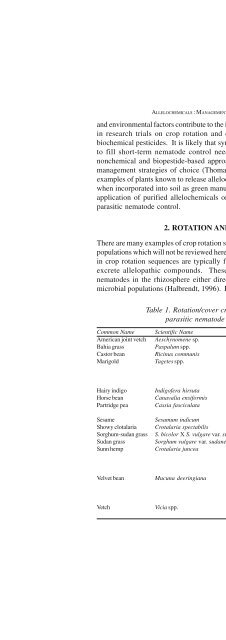Allelochemicals Biologica... - Name
Allelochemicals Biologica... - Name
Allelochemicals Biologica... - Name
Create successful ePaper yourself
Turn your PDF publications into a flip-book with our unique Google optimized e-Paper software.
ALLELOCHEMICALS : MANAGEMENT OF PLANT-PARASITIC NEMATODES 17<br />
and environmental factors contribute to the inconsistency of nematode control observed<br />
in research trials on crop rotation and cover crop systems, biofumigation, and<br />
biochemical pesticides. It is likely that synthetic chemical nematicides will continue<br />
to fill short-term nematode control needs while research continues to improve<br />
nonchemical and biopestide-based approaches, which will eventually become the<br />
management strategies of choice (Thomas, 1996). In this chapter we will review<br />
examples of plants known to release allelochemicals into soil while actively growing,<br />
when incorporated into soil as green manures or organic amendments, and the direct<br />
application of purified allelochemicals or formulations of biopesticides for plantparasitic<br />
nematode control.<br />
2. ROTATION AND COVER CROPS<br />
There are many examples of crop rotation sequences that passively suppress nematode<br />
populations which will not be reviewed here. Examples of active nematode suppression<br />
in crop rotation sequences are typically found with plant species that produce and<br />
excrete allelopathic compounds. These compounds then affect plant-parasitic<br />
nematodes in the rhizosphere either directly or indirectly by altering rhizosphere<br />
microbial populations (Halbrendt, 1996). For the purpose of this chapter, allelopathic<br />
Table 1. Rotation/cover crops that actively suppress<br />
parasitic nematode populations in soil.<br />
Common <strong>Name</strong> Scientific <strong>Name</strong> References<br />
American joint vetch Aeschynomene sp. Rodriguez-Kabana et al., 1991a<br />
Bahia grass Paspalum spp. Rodríguez-Kábana et al., 1994b<br />
Castor bean Ricinus communis Rodriguez-Kabana et al., 1991b<br />
Marigold Tagetes spp. Tyler, 1938<br />
Steiner, 1941<br />
Uhlenbroek and Bijloo, 1958, 1959<br />
Good et al., 1965<br />
Hairy indigo Indigofera hirsuta Rodriguez-Kabana et al., 1988b<br />
Horse bean Canavalia ensiformis Rodriguez-Kabana et al., 1992b<br />
Partridge pea Cassia fasciculata Rodriguez-Kabana et al., 1991a<br />
Rodriguez-Kabana et al., 1995<br />
Sesame Sesamum indicum Rodríguez-Kábana et al., 1994a<br />
Showy clotalaria Crotalaria spectabilis Rodriguez-Kabana et al., 1992b<br />
Sorghum-sudan grass S. bicolor X S. vulgare var. sudanense Kinloch and Dunavin, 1993<br />
Sudan grass Sorghum vulgare var. sudanense Mojtahedi et al., 1993a<br />
Sunn hemp Crotalaria juncea Sipes and Arakaki, 1997<br />
Robinson et al., 1998<br />
McSorley et al., 1999<br />
Wang et al., 2001<br />
Velvet bean Mucuna deeringiana Rodriguez-Kabana et al., 1992a<br />
Weaver et al., 1993<br />
Taylor and Rodriguez-Kabana, 1999<br />
Vargas-Ayala and Rodriguez-Kabana, 2001<br />
Vetch Vicia spp. Minton et al., 1966<br />
Minton and Donnelly, 1967


